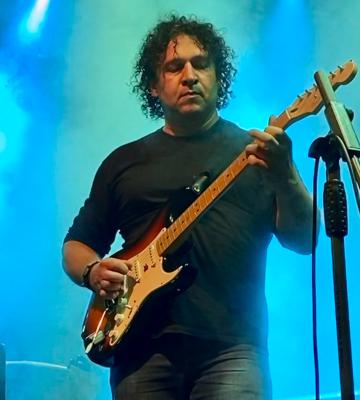More
- Who Is The (session) Guitarist?LEVEL 6A humble tribute to all those session guitarists, who often stand behind great pop artists.
- Whiskey In The JarLEVEL 2A nice and easy traditional Irish song for beginners.
- Where Is Santa? - Rhythm GuitarLEVEL 4This time the GMC hit song for last Christmas: Where is Santa. This lesson, or song, is focused on melodic death metal.
- In The Spirit Of 70sLEVEL 5Lead guitar improvisation in the style of 70s.
- Get In The PocketLEVEL 5Let's focus on the backbeat to play "in the pocket".
- The VocalistLEVEL 5Lesson covering my original guitar instrumental song.
- In Flames styleLEVEL 5This band has changed its style quite a bit through the years. The lesson is mostly inspired by "take this life" from the album Come Clarity.
- All InLEVEL 8This is a solo I did for a band named "Chat Noir" featuring bluesy phrasing, and some wider stretches in A minor.
- In HarmonyLEVEL 2A short series of phrases designed to help you understand and create your own harmonies
more
easier
Feedback
 Piotr Kaczor8th May 2011
Piotr Kaczor8th May 2011Great riffing and rythm patterns!
 Ben Higgins30th April 2011
Ben Higgins30th April 2011Thank you very much guys.. and yes, I am working with a new camera now, thanks for noticing ! :-)
 Justin Myrick29th April 2011
Justin Myrick29th April 2011Sweet riffs Ben!
 Jerry Arcidiacono29th April 2011
Jerry Arcidiacono29th April 2011Great rhythm lesson Ben!
 Ulrik29th April 2011
Ulrik29th April 2011Good one Ben, not too hard, but still very useful!
 Bogdan Radovic29th April 2011
Bogdan Radovic29th April 2011Very cool composition Ben! Great video quality!

 Ivan Milenkovic29th April 2011
Ivan Milenkovic29th April 2011Looks great man, and well played, I like those chord changes

 thefireball29th April 2011
thefireball29th April 2011That's cool! Interesting time changes! Did you get a new camera? It seems better quality.
 Ben Higgins29th April 2011
Ben Higgins29th April 2011Thank you Kris..! I'll try to resist jumping into the water with my guitar :-)
 Kristofer Dahl29th April 2011
Kristofer Dahl29th April 2011Very cool riffing Ben - and amazing video (don't take the guitar with you in case you should go swimming)
- Lesson
- My notes
Hi GMC'ers! There is a famous phrase 'The Devil is in the details' which this lesson is based on. I'm here to show that, for creating awesome riffs, the Devil is in the Diad!
We're looking at 2 note chords, called Diads. These are very useful shapes because they're easy to play and move between, effectively allowing you to make quicker chord changes which is especially useful in rock and metal, where players use distorted guitar tones.
A diad can be made up of any combination of notes. The lower note is usually the root note, but it doesn't always have to be the case. Diads are sometimes written as the notes, separated by a slash, for example E/B or A/C. However, in this lesson, I am using diads which outline the 2 basic notes of common Minor & Major chords so I will be referring to them as Em, D, C and so on. How does this work ? I am combining a root note and a minor or major 3rd. The 3rd is the interval that dictates whether a chord has a Minor or Major sound. So, with that approach, we can achieve that sound without needing extra intervals such as a 5th etc.
Another interesting thing to note is that all the chord shapes fall within the E minor scale, so they all work in a diatonic sequence.
Technique wise, this lesson involves quick shifting between shapes for your fretting hand. I only use 2 basic shapes throughout. As a result, I only use 2 different finger combinations so once you've learned these shapes, shifting between them should be easier. For the picking hand, we're using a lot of palm muted downstrokes for the first and last sections. Some sections require 16th note triplet alternate strumming, with no palm muting.
The lesson uses 3 different time signatures - 4/4, 6/8 & 2/4. The time signatures are written in the Gpro if you're interested, but for those of you who just want to knuckle down on the technique, it may be better to just feel how the song moves and just play it.
Tempo:
* 150bpm
Key:
E Minor
If you have any questions:
* Give feedback (upper-right-corner)
* My Personal Board
* General Forum
See you next time!/ Ben

Scrubbing / forward / rewind: arrow right, arrow left keys
Jump to start: Home or `s` , you can also click/tap the lesson part again (the numbers above player)
Go to next part: PageUP or End.
Volume: ArrowUp / ArrowDown keys
Go to any part: Number keys (combinations also possible)
Pause or play: `k` or space key
Fullscreen: `f`, esc to close
Increase / decrease speed : `+` or `-`
Jump to start: Home or `s` , you can also click/tap the lesson part again (the numbers above player)
Go to next part: PageUP or End.
Volume: ArrowUp / ArrowDown keys
Go to any part: Number keys (combinations also possible)
Pause or play: `k` or space key
Fullscreen: `f`, esc to close
Increase / decrease speed : `+` or `-`







